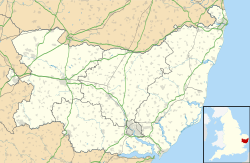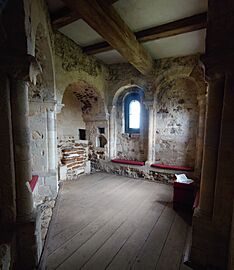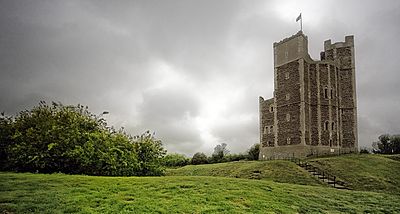Orford Castle facts for kids
Quick facts for kids Orford Castle |
|
|---|---|
| Suffolk, England | |

The keep of Orford Castle
|
|
| Coordinates | 52°05′37″N 1°31′48″E / 52.0936°N 1.5300°E |
| Grid reference | grid reference TM419498 |
| Type | Keep and bailey |
| Site information | |
| Owner | English Heritage |
| Open to the public |
Yes |
| Condition | Keep remains |
| Site history | |
| Materials | Caen stone, mudstone, coralline, Northamptonshire limestone |
Orford Castle is a cool old castle in Orford, a town in the English county of Suffolk. It's about 12 miles (19 km) northeast of Ipswich. From the castle, you can see amazing views over Orford Ness.
King Henry II of England had Orford Castle built between 1165 and 1173. He wanted to make sure the king's power was strong in this area. The main tower, called the keep, is still in great shape. Experts say it's one of the most amazing keeps in England. Its design is very special and might even be based on buildings from the Byzantine Empire. The keep stands inside the remains of the castle's outer walls, which were made of earth.
Contents
Discovering Orford Castle's Past
How Orford Castle Was Built (12th Century)
Before Orford Castle was built, a powerful family called the Bigods controlled Suffolk. They were the Earls of Norfolk and owned important castles like Framlingham and Bungay. Hugh Bigod had even fought against King Stephen in a civil war.
King Henry II wanted to take back control. So, he took away four castles from Hugh. In 1165, Henry gave Framlingham and Bungay back to Hugh. But then, Henry decided to build his own royal castle at Orford. It was close to Framlingham. Building work started in 1165 and finished in 1173.
The castle site was about 2 miles (3.2 km) from the sea. It was on flat land with swampy areas leading down to the River Ore. This river was about half a mile (0.8 km) away.
The Keep: A Unique Design
The main tower, or keep, of Orford Castle was truly one-of-a-kind. It's been called "one of the most remarkable keeps in England." The central tower was round and stood 90 feet (27 meters) tall. Three rectangular towers stuck out from its 49-foot-wide (15-meter) base.
The tower's design used exact measurements. Its different parts followed a special ratio often seen in English churches back then. Inside, much of the castle was built with high-quality stone. The staircases were wide, about 5 feet 6 inches (1.7 meters). The best rooms were planned to catch the morning sun. Doors and windows were carefully made to keep out drafts.
Originally, the roof of the keep, above the upper hall, looked like a dome. A tall steeple stood above that. The chapel, located above the entrance, had an unusual shape. Some historians think this design was not typical for a holy room.
The keep was surrounded by a curtain wall. This wall likely had four towers and a strong gatehouse. These outer defenses protected a fairly small courtyard, or bailey. These outer parts, not the keep itself, were probably the castle's main protection. Nearby marshes were drained, which helped turn Orford village into a safe port.
The castle, including its ditch, wooden fence, and stone bridge, cost about £1,413 to build. This was a lot of money back then! A master builder named Alnoth might have led the work. Some wood for the castle came from as far away as Scarborough. The detailed stone carvings were made from Caen limestone from Normandy. Other stones used were local mudstone, coralline, and limestone from Northamptonshire.
Why the Keep Looks So Different
Historians have been very interested in the keep's unique design. Some used to think it was a "transitional" design. They believed it mixed the round shapes of later castles with the square corners of older Norman castles. However, newer studies disagree.
The design of the Orford keep doesn't make much sense for defense. The sticking-out towers created blind spots for the defenders. Also, the rooms and stairs in the corners made the walls weaker. Square Norman keeps were still built after Orford. King Henry II also knew about fully round castle designs before building Orford. For example, a round keep was built at New Buckenham, Norfolk, in 1146. So, historians now question if it was truly a "transitional" design.
Instead, many historians now believe the design of Orford Castle was mostly about showing power and symbolism. Architectural historian Sandy Heslop suggests that the simple, elegant look of the castle would have reminded people of King Arthur in the mid-12th century. People then thought King Arthur had Roman or Greek connections. The striped, angled features of the keep looked like the Theodosian Walls of Constantinople. This city was seen as the perfect example of imperial power. The whole keep, including its roof, might have been based on a hall recently built in Constantinople by John II Komnenos.
Orford Castle Through the Centuries (13th to 19th)
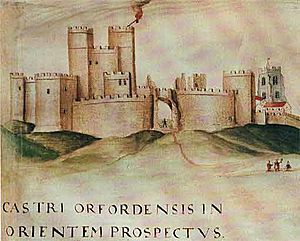
By the early 1200s, the king's power in Suffolk was very strong. This happened after Henry II crushed the Bigod family in a rebellion in 1173–1174. Orford Castle had many soldiers during this fight, with 20 knights stationed there. After the rebellion ended, Henry ordered Framlingham Castle to be taken permanently.
Orford Castle became less important after Henry's death in 1189. However, the port of Orford grew. By the early 13th century, it handled more trade than the more famous port of Ipswich.
In 1216, Prince Louis of France invaded England. He was invited by English barons who were unhappy with King John. Prince Louis captured Orford Castle. Later, John Fitz-Robert became the governor of the royal castle under the young Henry III. Then Hubert de Burgh took over.
Under Edward I, the castle was given to the de Valoines family. It then passed to Robert de Ufford, the first Earl of Suffolk, through marriage. King Edward III gave it to him forever in 1336. The Uffords updated the castle. They added glass to the windows and put wood panels in some rooms. Even with these changes, the earl and his family probably only used Orford Castle sometimes. Their large household would have needed more space.
Orford Castle was no longer a royal castle. It passed through the Willoughby, Stanhope, and Devereux families. Meanwhile, the local economy of Orford started to decline. The mouth of the River Ore filled with silt, and the Orford Ness sand spit grew. This made it harder for ships to get to the harbor. As a result, trade decreased, and the castle became less important for local government.
The castle eventually belonged to Michael Stanhope. He asked John Norden to survey his family's lands. The oldest picture of the castle comes from this survey. Stanhope built a new home in Sudbourne in 1604 and 1605. He likely used stones from Orford Castle for his new house.
The Seymour-Conway family bought the castle and nearby lands in 1754. By the late 1700s, only the north wall of the outer courtyard remained. The roof and upper floors of the keep were badly damaged. Francis Seymour-Conway, the second Marquess of Hertford, wanted to destroy the building in 1805. But the government stopped him. They said the keep was a valuable landmark for ships coming from Holland to avoid sandbanks.
Francis's son, also named Francis, worked to save the castle in 1831. He put in a new, flatter lead roof and a replacement upper floor. Francis even furnished the top of the keep as an apartment for guests. However, by the 1840s, almost all of the surrounding outer wall and its towers had disappeared. Their stones had been taken for other uses, and only the foundations could barely be seen.
Orford Castle Today
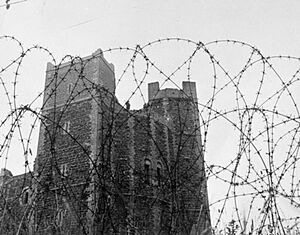
Sir Arthur Churchman bought Orford Castle in 1928. He then gave it to the Orford Town Trust. Soon after, people started raising money to fix and restore it. In 1930, the castle opened to the public.
During the Second World War, the castle was made stronger with barbed wire. It was first meant to be an anti-aircraft gun spot. Nissen huts were built around the keep. But instead, the castle was used as a radar station. A concrete floor was put in the south-east tower to hold the equipment. These wartime buildings were removed after the war. The Ministry of Information took many propaganda photos around Orford. These photos, called "Invasion Village," showed life in the village. They also compared the old castle with new defenses to show that history was in danger.
Orford Castle was given to the Ministry of Works in 1962. Now, English Heritage takes care of it. The first guide book for the castle came out two years later. It was written by R. Allen Brown. Other guidebooks have been written by different historians since then.
The keep is the only part of the castle that is still whole. But you can still see the earth mounds that were once the outer walls. Some of the ditches you see are not from medieval times. They are from later times when people dug up stones from the walls. Archeologists have continued to study the area, most recently from 2002 to 2003. The castle is a protected historical site and a Grade I listed building.
English Heritage maintains the castle, and it also hosts the Orford Museum. The museum moved into the castle's upper hall in 2005. It had been without a home since 1998. The Orford Museum Trust has created exhibits there. They display old objects found in the local area.
In the 21st century, English Heritage started a project to stop the decay of the mudstone used to build the castle. This stone had been wearing away since at least the 1500s. In 2008, English Heritage began testing different ways to save the stone. After many tests, a £1 million project started in 2022. The plan is to cover the castle in a special lime render to protect it.
The Wild Man of Orford: A Local Legend
Orford Castle is famous for a legend called the Wild Man of Orford. A writer named Ralph of Coggeshall told this story. He said that around 1167, local fishermen caught a naked, hairy wild man in their nets. The man was brought to the castle and held for six months. People tried to question him, and some even tried to hurt him. But he never spoke and acted like a wild animal. The wild man eventually escaped from the castle.
Later stories described him as a merman, a creature that is half-man and half-fish. This event seems to have made people carve "wild men" on local baptismal fonts. About twenty such fonts from the later medieval period can be found in coastal areas of Suffolk and Norfolk, near Orford.
More to Explore


